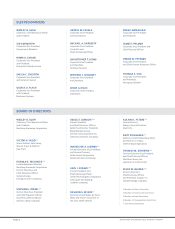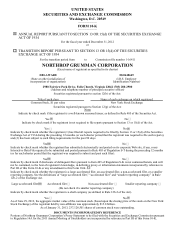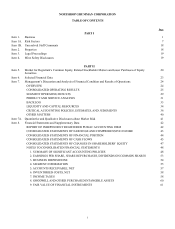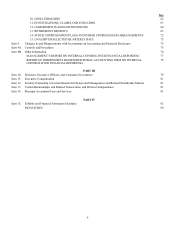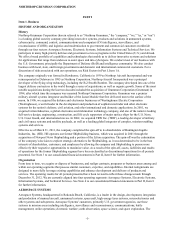Northrop Grumman 2012 Annual Report Download - page 16
Download and view the complete annual report
Please find page 16 of the 2012 Northrop Grumman annual report below. You can navigate through the pages in the report by either clicking on the pages listed below, or by using the keyword search tool below to find specific information within the annual report.
NORTHROP GRUMMAN CORPORATION
-6-
percentage of costs. Award fees are based on performance criteria such as cost, schedule, quality, and technical
performance. Award fees are determined and earned based on an evaluation by the customer of the company's
performance against negotiated criteria, and are intended to provide motivation for excellence in contract
performance. Incentive fees provide for an initially negotiated fee to be adjusted later by a formula based on the
relationship of total allowable costs to total target costs. Award fees and incentive fees that can reasonably be
estimated and are deemed reasonably assured are recorded over the performance period of the contract.
Fixed-price contracts – A firm fixed-price contract is a contract in which the specified scope of work is agreed to for
a price that is a pre-determined, negotiated amount and not generally subject to adjustment regardless of costs
incurred by the contractor, absent changes in scope by the customer. Fixed-price incentive contracts provide for
reimbursement of the contractor’s allowable costs plus a fee up to a ceiling amount, but are subject to a cost-share
limit that affects profitability. Fixed-price incentive contracts effectively become firm fixed-price contracts once the
cost-share limit is reached. Time-and-materials contracts are considered fixed-price contracts as they specify a fixed
hourly rate for each labor hour charged.
The following table summarizes revenues for the year ended December 31, 2012, recognized by contract type and
customer:
($ in millions) U.S.
Government Other
Customers Total Percent
of Total
Cost-type contracts $13,732 $ 283 $14,015 56%
Fixed-price contracts 8,976 2,227 11,203 44%
Total sales $22,708 $2,510 $25,218 100%
Profit margins may vary materially depending on, among other things, the negotiated contract fee arrangements, the
achievement of performance objectives, and the stage of performance at which the right to receive fees, particularly
under incentive and award fee contracts, is finally determined.
We monitor our policies and procedures with respect to our contracts on a regular basis to enhance consistent
application under similar terms and conditions, as well as compliance with all applicable government regulations
and laws. In addition, costs incurred and allocated to contracts with the U.S. Government are routinely audited by
the Defense Contract Audit Agency (DCAA).
Environmental
Our manufacturing operations are subject to and affected by federal, state, foreign, and local laws and regulations
relating to the protection of the environment. The estimated cost to complete remediation is accrued when it is
probable that the company will incur costs to address environmental impacts at sites where the company has been
named a Potentially Responsible Party (PRP) and the costs are estimable. To assess the potential impact on the
company’s financial statements, management estimates the range of reasonably possible remediation costs that could
be incurred by the company, taking into account the facts currently available to the company regarding each site, as
well as the current state of technology and prior experience. These estimates are reviewed periodically and adjusted
to reflect changes in facts and circumstances. See Risk Factors in Part I, Item 1A, as well as Note 12 to the
consolidated financial statements in Part II, Item 8.
In 2009, we established a goal of reducing our greenhouse gas emissions over a five-year period through
December 31, 2014. In 2010, we established goals for water usage and solid waste generation. For information on
the progress towards achieving our goals, refer to our Corporate Responsibility Report on our Web site. The
information contained in our Corporate Responsibility Report should not be deemed to be incorporated by reference
into this report.
We have incurred and expect to continue to incur capital and operating costs to comply with applicable
environmental laws and regulations and satisfy green initiatives, including our goals. At this time, these costs have
not had, and we do not expect that these costs will have, a material adverse effect on our consolidated financial
position, results of operations or cash flows.
EXECUTIVE OFFICERS
See Part III, Item 10, for information about our executive officers.


